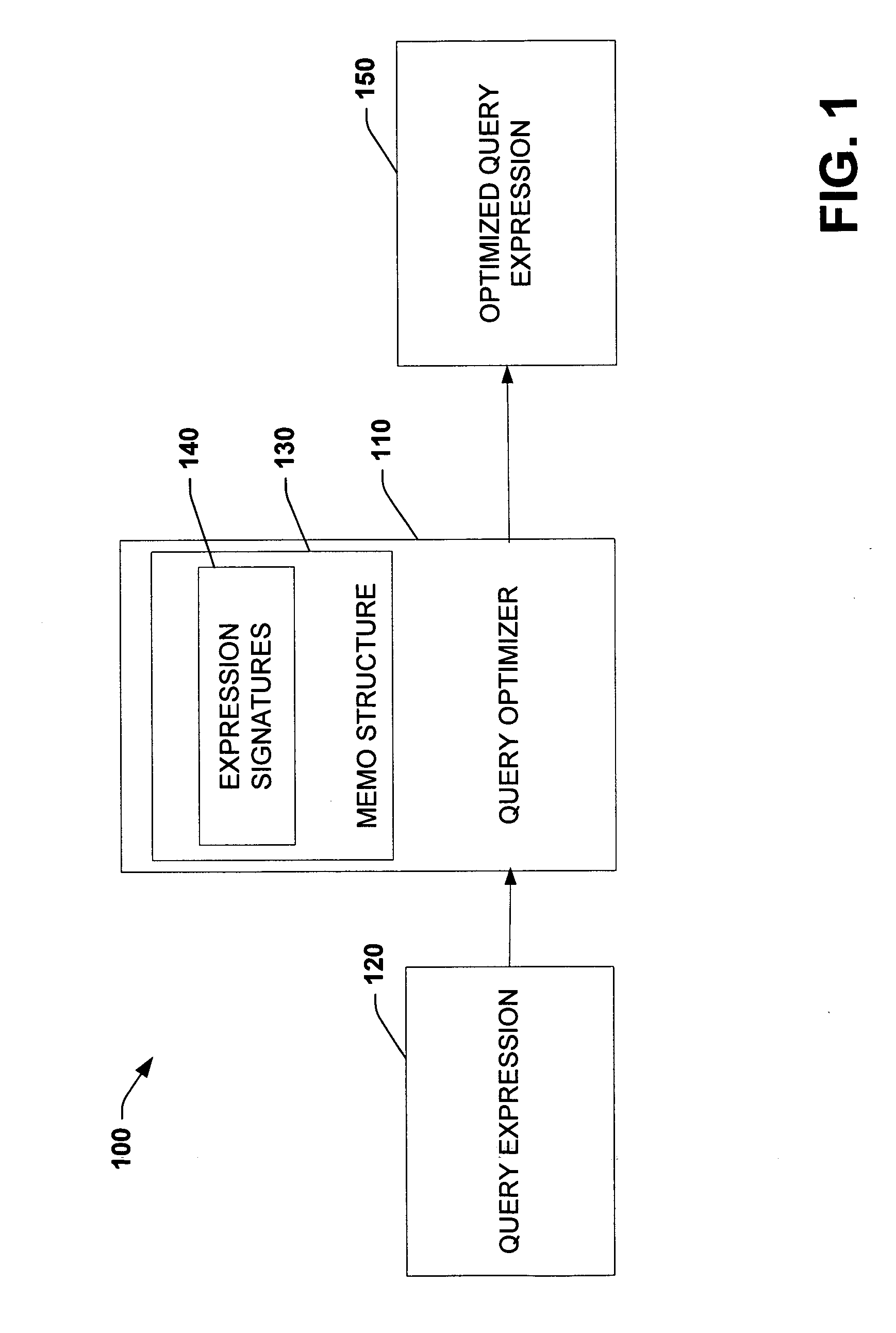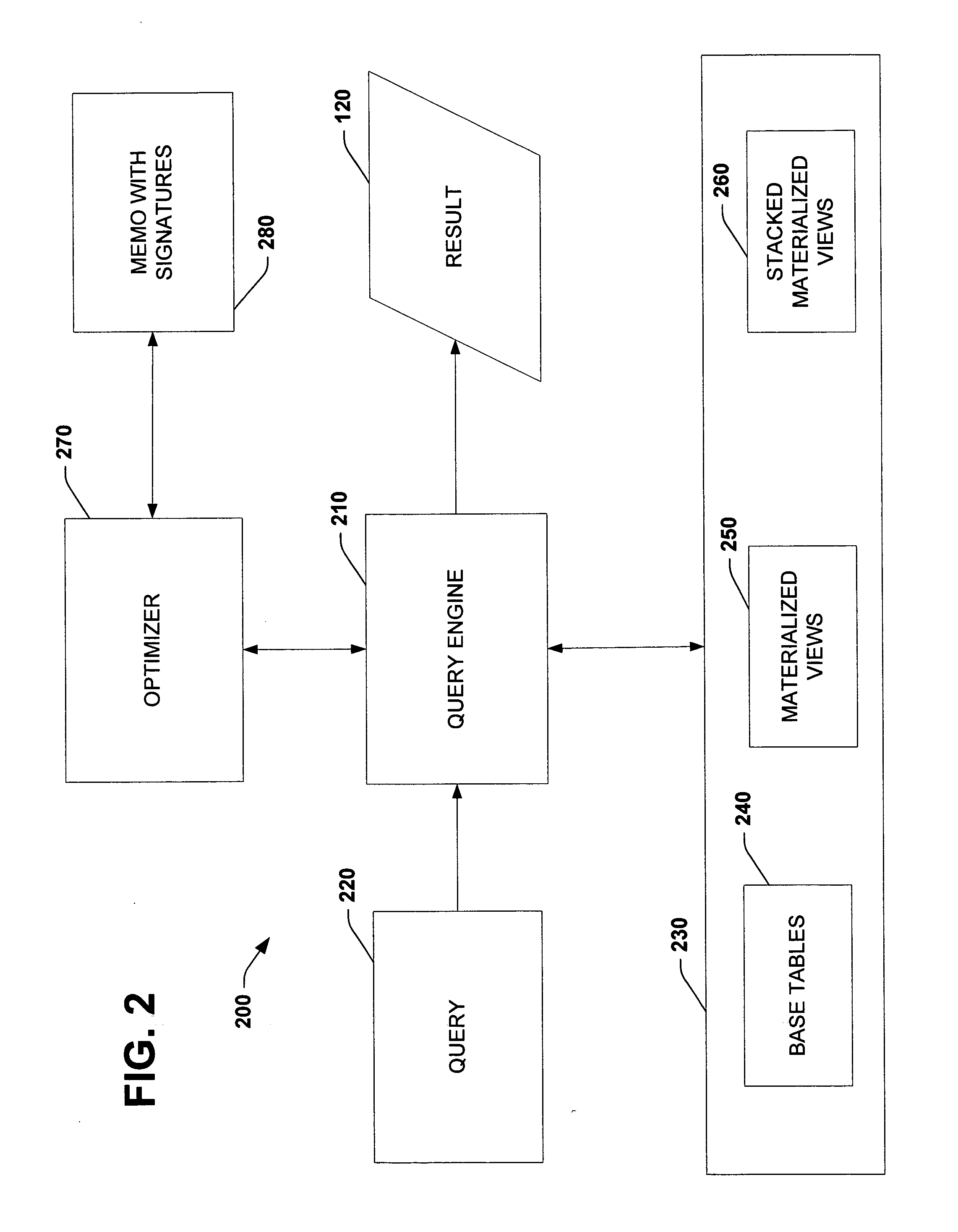Using query expression signatures in view matching
a query expression and view matching technology, applied in the field of database systems, can solve the problems of high computational cost, large computation time, and inability to achieve significant efficiency gains, and achieve the effect of quick and efficient processing, improved overall efficiency of the database system, and reliably and efficiently recognizing opportunities
- Summary
- Abstract
- Description
- Claims
- Application Information
AI Technical Summary
Benefits of technology
Problems solved by technology
Method used
Image
Examples
example 1
[0030] A sample query against a parts database contains two levels of aggregation and attempts to find important parts. A part is important if it contributed at least 90% of the value of an order. The fact that the query has two levels of aggregation means that the query cannot be well supported by SPJG views only. For brevity, np (net price) is used in place of the expression l_extendedprice*(1+l_tax)*(1−l_discount).
[0031] Q: select l_partkey, count(*) ocnt, sum(sp) oval [0032] from orders, [0033] (select sum(np) sp, l_orderkey, l_partkey [0034] from lineitem [0035] group by l_orderkey, l_partkey) as x [0036] where o_orderkey=l_orderkey [0037] and o_totalprice*0.9[0038] group by l_partkey
[0039] V1: select sum(np) sp, l_orderkey, l_partkey [0040] from lineitem [0041] group by l_orderkey, l_partkey
[0042] V2: select l_partkey, count(*) ocnt, sum(sp) oval [0043] from orders, V1 [0044] where o_orderkey=l_orderkey [0045] and o_totalprice*0.9[0046] group by l_partkey
[0047] The query o...
example 2
[0051] A sample query is made of a database that includes the following three views:
[0052] V1: create view q11v1 with schemabinding as [0053] select n_name, ps_partkey, [0054] sum(ps_supplycost*ps_availqty) as value, [0055] count_big(*) as cut [0056] from dbo.partsupp, dbo.supplier, dbo.nation [0057] where ps_suppkey=s_suppkey [0058] and s_nationkey=n_nationkey [0059] group by n_name, ps_partkey
[0060] V2: create view q11v2 with schemabinding as [0061] select n_name, sum(value) as value-by-nation, [0062] count_big(*) as cnt [0063] from dbo.q11v1 [0064] group by n_name
[0065] V3: create view q11v3 with schemabinding as [0066] select v1.n_name, ps_partkey, value [0067] from dbo.q11v1 v1, dbo.q11v2 v2 [0068] where v1.n_name=v2.n_name [0069] and value>value_by_nation*0.0001
The original form of a query q11 that takes one parameter a country name represented as @p1, is as follows:
[0070] Q: select ps_partkey, [0071] sum(ps_supplycost*ps_availqty) as val [0072] from partsupp, supplier, ...
example 5
[0137] Query Q classifies orders by the number of line items that each order contains with a particular return flag.
[0138] Q: select lcount, count(*) [0139] from orders, [0140] (select l_orderkey, count(*) lcount [0141] from lineitem [0142] where l_returnflag=@p1 [0143] group by l_orderkey) AS X [0144] where l_orderkey=o_orderkey [0145] and o_orderdate>=@p2 [0146] group by lcount [0147] order by lcount desc
Q can be supported using the following views that add parameterized columns to the grouping and output columns of each level of view:
[0148] V1: select l_orderkey, l_returnflag, count(*) lcount [0149] from lineitem [0150] group by l_orderkey, late
[0151] V2: select lcount, l_returnflag [0152] o_orderdate, count(*) ocount [0153] from orders, V1 [0154] where l_orderkey=o_orderkey [0155] group by lcount, l_returnflag, o_orderdate
[0156] Q′: select lcount, sum(ocount) [0157] from V2 [0158] where l_returnflag=@p1 [0159] and o_orderdate>=@p2 [0160] group by lcount [0161] order by lco...
PUM
 Login to View More
Login to View More Abstract
Description
Claims
Application Information
 Login to View More
Login to View More - R&D
- Intellectual Property
- Life Sciences
- Materials
- Tech Scout
- Unparalleled Data Quality
- Higher Quality Content
- 60% Fewer Hallucinations
Browse by: Latest US Patents, China's latest patents, Technical Efficacy Thesaurus, Application Domain, Technology Topic, Popular Technical Reports.
© 2025 PatSnap. All rights reserved.Legal|Privacy policy|Modern Slavery Act Transparency Statement|Sitemap|About US| Contact US: help@patsnap.com



